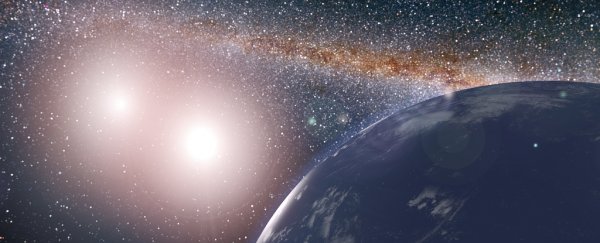Almost all the large vertebrates on Earth suddenly went extinct 66 million years ago – including dinosaurs, mosasaurs, plesiosaurs, and pterosaurs.
A city-size asteroid or comet is thought to be responsible for that mass extinction. The impact, called the Chicxulub event, triggered global cooling and volcanic eruptions that transformed Earth.
In the 1980s, Richard Muller, a physicist at the University of California, Berkeley, introduced the idea that a hypothetical twin star of our Sun - known as its "Nemesis" - might have played a role in that asteroid crash (and others) by agitating a comet belt in our Solar System with its gravity.
"The Nemesis Theory is an outgrowth of the discovery that the impact of a large comet or asteroid may have been responsible for the great mass extinction," Douglas Vakoch, president of a nonprofit called Messaging Extraterrestrial Intelligence, told Business Insider.
The logic was that the five extinctions that have occurred on Earth to date happened in regular intervals. So some scientists believed that may be explained by a cyclical pattern of strong comet activity, which could be caused by the presence of another star in our Solar System.
A 2017 study by researchers at the University of California at Berkeley gave credence to this idea by suggesting that nearly all stars form with a companion. The study modelled the process of star formation - which starts with clouds of gas and dust that become dense - based on a survey of a giant cloud in the constellation Perseus.
As it turned out, the calculations only worked if stars were born as twins.
"Studies of star formation in the constellation Perseus suggest that most if not all stars the size of our Sun originate as part of binary star systems," Vakoch said.
"Over half of these binary star systems later split up, with each star going its own way."
The Nemesis theory
When he introduced his Nemesis idea, Muller posited that the twin star might periodically intersect with the Oort Cloud, a sphere of icy bodies far beyond Pluto and the most distant edges of the Kuiper Belt.
Many of these bodies travel around the Sun in long-term, elliptical orbits. Muller's idea was that as these objects draw closer to the distant star, their ice begins to melt and stream behind them, making them recognisable as comets.
"When Nemesis passes through the Oort cloud, the theory goes, it dislodges comets that in turn make their way to Earth, causing cataclysmic events," Vakoch said.
If Nemesis travelled through the Oort cloud every 27 million years, that could explain the five mass extinctions on Earth.
Those events include the extinction of dinosaurs, "the great dying" that occurred 251 million years ago and eliminated 96 percent of species, and an extinction 375 million years ago in which 75 percent of species were lost.
At the time, Muller suggested our technology simply wasn't good enough to observe the Nemesis.
So where is it?
Although it's possible that our Sun formed as one of two stars in a pair, there's not much scientific support for idea that its evil twin stuck around and wreaked havoc in the Solar System.
Muller's theory suggested that Nemesis could be located about 1.5 light years from our Sun - a distance physicists' tools now allow us to see. But all attempts to locate the Nemesis have failed.
After searching millions of objects in our solar system, NASA's Wide-Field Infrared Survey Explorer (WISE) telescope found no evidence of a twin star to the Sun.
A spokesperson for NASA told Business Insider via email that "the existence of Nemesis is an old hypothesis and has been largely disproven."
"It's perfectly reasonable to think that our Sun was part of a binary star system sometime in the first million years of its life," Vakoch said.
"But that was over 4 billion years ago."
Scientists have investigated the possible existence of the Nemesis by relying on other clues as well.
Physicist Adrian Melott and paleontologist Richard Bambach examined the fossil record on Earth over the past half-billion years and noted in an article in the Monthly Notices of the Royal Astronomical Society that mass extinctions have followed a roughly 27-million-year cycle.
While a regular pattern of asteroid-triggered extinctions could indicate that some orbital force is involved, they wrote that "the regularity of the timing compared with earlier calculations of orbital perturbation would seem to exclude the Nemesis hypothesis as a causal factor."
Mordecai-Mark Mac Low, curator of the American Museum of Natural History's department of astrophysics, echoed that stance.
"The Nemesis hypothesis has far more evidence against it than for it," he said, adding, "Regular passages of a massive object of this nature would have left a clear imprint on the crater distribution on the moon, and the dynamical structure of the minor bodies of the solar system, including the asteroids and Kuiper Belt objects, and no such signals have been observed."
A not-so-evil twin
Any star that may have orbited close to our Sun in its early days probably didn't deserve the name Nemesis, as intriguing and dramatic as it sounds.
Life arose here long after that star separated from our Sun and joined the hundreds of billions of stars that make up our Milky Way Galaxy, so the star isn't responsible for the mass extinctions on Earth.
"If the Sun really was part of a binary star system in its early days, its early twin deserves a benign name like Companion, rather than the threatening Nemesis," Vakoch said.
This article was originally published by Business Insider.
More from Business Insider:
